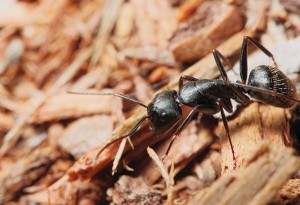
Carpenter ant treatments that are odorless don’t usually leave a noticeable scent.Photo: ©iStock.com/JackF
Carpenter ants (Camponotus spp.) are a diverse group of ants found throughout the world, and according to Bolton’s Catalogue and Synopsis from 2012, there are currently 1,058 species, 495 subspecies, and 31 fossil species of Camponotus known worldwide. The evenly rounded thorax of carpenter ants distinguishes them from other ant species. This physical characteristic can help in identifying carpenter ants from other ants when observing them from the side. Other ants may have a more flattened or uneven thorax when viewed from the side, making them distinguishable from carpenter ants. Carpenter ants are known for their large size, with queens typically measuring 16-18 millimeters in length and workers varying from 6-13 millimeters in length. This variation in worker size is known as polymorphism and is a common characteristic of carpenter ants. In contrast, some ant species have workers that are all the same size, which is known as monomorphism (Hansen and Antonelli, 2005).
While carpenter ants are known to nest and forage in wood, including trees, they can also be found in a variety of other places and habitats, including both natural and human-made environments. In addition to trees, carpenter ants can be found in dead or decaying wood, such as logs, stumps, and woodpiles. They can also be found in homes and buildings, particularly in areas where wood has been exposed to moisture or is in a state of decay, such as in walls, attics, and crawl spaces. Carpenter ants are also known to forage for food in a wide range of environments, including gardens, trash cans, and even inside homes where they may be attracted to sugary or protein-rich foods.
Carpenter ants, like most ants, undergo a complete metamorphosis, meaning they go through four distinct life stages: egg, larva, pupa and adult. The colony is typically headed by a single queen, who is responsible for laying eggs and can live for several years. The queen’s role is critical to the success of the colony, as she produces all the worker ants that forage for food, care for the brood, and defend the colony. While most North American carpenter ant species have a single queen, according to the study by Akre et al. (1994), some colonies ofthe bicolored carpenter ant species (C. vicinus) can have multiple queens. The number of queens in a colony can vary depending on environmental factors and other conditions.
Akre and Antonelli’s study from 1992 focused on the biology and behavior of carpenter ants in the genus Camponotus. They observed the foraging behavior of carpenter ants in natural settings and found that workers of different sizes had different roles in the colony. Larger workers were found to be more effective at carrying large food items, while smaller workers were better at finding and transporting small food items. This information can be useful when using granular baits to control carpenter ants. Granular baits are small, pellet-like insecticides that are designed to be carried back to the colony by worker ants, where they can eliminate the queen and other members of the colony.
Useful References
Hansen, L. D. and A. L. Antonelli. 2005. Carpenter ants: Their biology and control. WSU Coop. Ext. Bull. 0818. 6p.
Akre, R.D. and A.L. Antonelli. 1992. Identification and Habits of Key Ant Pests of Washington (Workers and Winged Reproductives) WSU CES. EB 0671.
Bolton B. Bolton’s Catalogue and Synopsis version: 1 January 2012. [2012-01-10T00:00:00+02:00]; 2012
Hansen, L. D. and R. D., Akre. 1985. Biology of carpenter ants in Washington State (Hymenoptera: Formicidae: Camponotus). Melanderia 43: 1–62.
Hansen, L. D. and J. H. Klotz. 2005. Carpenter ants of the United States and Canada. Cornell University Press. Ithaca, New York. 204 p
Leave A Comment